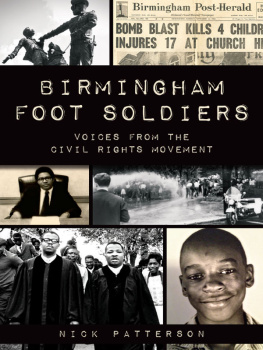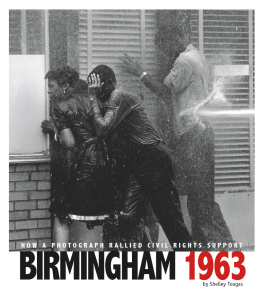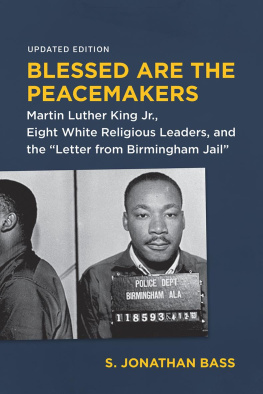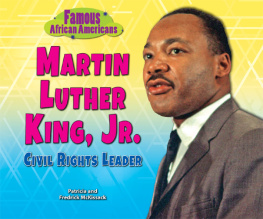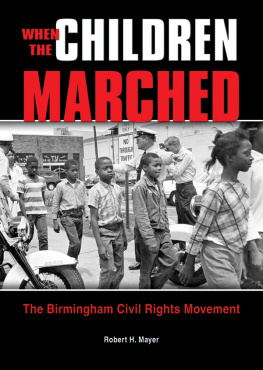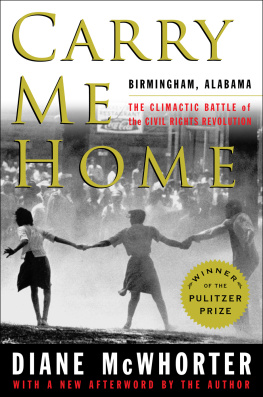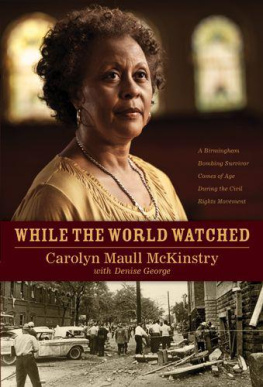

Published by The History Press
Charleston, SC 29403
www.historypress.net
Copyright 2014 by Nick Patterson
All rights reserved
Images are courtesy of the author unless otherwise noted.
First published 2014
e-book edition 2014
ISBN 978.1.62584.696.9
Library of Congress Cataloging-in-Publication Data
Patterson, Nick, 1960
Birmingham foot soldiers : voices of the civil rights movement / Nick Patterson.
pages cm
Includes index.
print edition ISBN 978-1-62619-220-1
1. African Americans--Civil rights--Alabama--Birmingham--History--20th century. 2. African American civil rights workers--Alabama--Birmingham--Biography. 3. Civil rights workers--Alabama--Birmingham--Biography. 4. Civil rights movements--Alabama--Birmingham--History--20th century. 5. Birmingham (Ala.)--Race relations. I. Title.
F334.B69N465 2014
323.11960730761781--dc23
2014011081
Notice: The information in this book is true and complete to the best of our knowledge. It is offered without guarantee on the part of the author or The History Press. The author and The History Press disclaim all liability in connection with the use of this book.
All rights reserved. No part of this book may be reproduced or transmitted in any form whatsoever without prior written permission from the publisher except in the case of brief quotations embodied in critical articles and reviews.
To the God of Truth, who witnesses all the untold stories.

A.D. King (right), pastor of a Birmingham church and brother of Martin Luther King, and another minister lead foot soldiers in a protest. Image courtesy of the Birmingham Public Library Archives.
FOOT SOLDIERS
The support grew to overwhelming proportions, overwhelmed the systems of jail and abuse and courts of illegitimate practicereally broke the back of segregation in Birmingham.
Birmingham movement leader Fred Shuttlesworth, pastor of Bethel Baptist Church, founder of the Alabama Christian Movement for Human Rights
You cant lead if you dont have followers. Martin Luther King said that a number of times. You cant fill the jail cells up with the leaders.
Horace Huntley, historian, former director of the Oral History Project of the Birmingham Civil Rights Institute, main author of
Foot Soldiers for Democracy
Who were the foot soldiers who stood up to such vicious violence? Who were the folks who made this movement, whose courage forced the city to negotiate and the federal government to intervene? Who were those unnamed idealists, who, in deeds rather than words, helped author Kings renowned Letter from Birmingham Jail?Many foot soldiers have stories yet to be told.
Historian Robin D.G. Kelley from the introduction to
Foot Soldiers for Democracy
The Foot Soldiers of this revolution followed these leaders and through their collective effort helped usher the end to public segregation and passage of the Civil Rights Act of 1964, the cornerstone of civil rights lawThe Foot Soldiers were ordinary men, women and children possessing extraordinary fortitude by marching for justice and equality within a society blinded by racism.
City of Birmingham document calling for creation of A monument to foot soldiers, a national design competition, for architects, artists, designers
CONTENTS
PREFACE/CONTROVERSY
Writing a book about foot soldiers in the Birmingham civil rights movement is a daunting task, not least because historians and journalists of note have done it before. The year 2013 was fifty years after the most pivotal struggles in the citys turbulent, seemingly intractable fight over segregation. Alabamas largest city was filled with the sights and sounds of commemorations: re-created marches; tours by the busload visiting the Birmingham Civil Rights Institute (BCRI), Sixteenth Street Baptist Church, Kelly Ingram Park and other sites of important protests and confrontations; banquets; speeches; exhibitions; concerts; and, yes, pages and pages of writingall centered on the subject of the movement.
And so, as this book began and ended, words were flowing from more and more writers about the marches, their leadersMartin Luther King and Fred Shuttlesworthand, most notably, inevitably and appropriately, the marchers themselves, the foot soldiers.
Just as I was starting this book, the Metro Birmingham Branch of the National Association for the Advancement of Colored People (NAACP) was starting a Foot Soldier Finder project, with the aim of locating more of those unknown soldiers who marched among the thousands. Most of the foot soldiers, people who really were the boots on the ground, they dont feel that they have received the appropriate level of even respect because in their minds others benefited from their work, they benefited from their sacrifices, they benefited from their struggle, said Hezekiah Jackson, president of that NAACP branch.
Even before 2013, many have broached the subject. One of the most notable predecessors for this book is Foot Soldiers for Democracy, principally authored by historian Horace Huntley in conjunction with the Birmingham Civil Rights Institutes Oral History Project, which Huntley was integral in inaugurating. Other books, like Taylor Branchs Parting the Waters and Diane McWhorters Carry Me Home: Birmingham, Alabama, the Climactic Battle of the Civil Rights Revolution, have dealt with the Birmingham movement to international acclaim. The Birmingham Historical Society has published several volumes of material on the subject, some of which I refer to herein.
Local newspapers, including the Birmingham News, the Birmingham Times and the papers for which I have workedthe now-closed Birmingham Post-Herald and the relatively younger weekly called Weld (which I currently edit)have dealt extensively at various times with the history of civil rights in Birmingham. And so I have already had the privilege of interviewing several foot soldiers myself and editing the work of others who have written about their stories.
So it is a field crowded with entrants. And yet there is so much more to tell.
Indeed, there were so many people who risked their safety against the civic machine run largely by the infamous public safety commissioner Theophilus Eugene Bull Connor by participating in nonviolent sit-ins, leaflet campaigns, picketing, mass meetings, marches and other demonstrations that there are literally thousands of stories to tell. I endeavor to tell only a few of them.
In doing so, I have striven to report facts as a journalist would, as accurately as possible and certainly without any illusion that Im the first on the scene of this story. Still, I believe that the more voices of those who were there that can be heard, the better for the completion of the story. Some of it might still never be known, however.
For one reason, as you can well imagine, some of those who participated have since died, taking their recollections and insights with them. For some, the events that unfolded here left scars, deep wounds. One man I talked to said he knew he had suffered posttraumatic stress disorder after being shot in the Vietnam War, but it wasnt until he started talking about the stress he experienced while being harassed by racists and locked up for marching in Birmingham in the years before the war that he started to heal.
Next page
